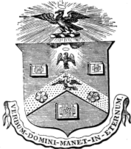St Bride's Church
17th-century Church of England church buildingsBuildings and structures in the United Kingdom destroyed during World War IIChristopher Wren church buildings in LondonChurch of England church buildings in the City of LondonChurches bombed by the Luftwaffe in London ... and 5 more
Diocese of LondonEnglish Baroque architectureGrade I listed churches in the City of LondonRebuilt churches in the United KingdomUse British English from November 2013

St Bride's Church is a church in the City of London, England. The building's most recent incarnation was designed by Sir Christopher Wren in 1672 in Fleet Street in the City of London, though Wren's original building was largely gutted by fire during the London Blitz in 1940. Due to its location in Fleet Street, it has a long association with journalists and newspapers. The church is a distinctive sight on London's skyline and is clearly visible from a number of locations. Standing 226 feet (69m) high, it is the second tallest of all Wren's churches, with only St Paul's itself having a higher pinnacle.
Excerpt from the Wikipedia article St Bride's Church (License: CC BY-SA 3.0, Authors, Images).St Bride's Church
Saint Paul's Church Yard, City of London
Geographical coordinates (GPS) Address Nearby Places Show on map
Geographical coordinates (GPS)
| Latitude | Longitude |
|---|---|
| N 51.513888888889 ° | E -0.10027777777778 ° |
Address
M&S Simply Food
Saint Paul's Church Yard 100
EC4M 8BU City of London
England, United Kingdom
Open on Google Maps










